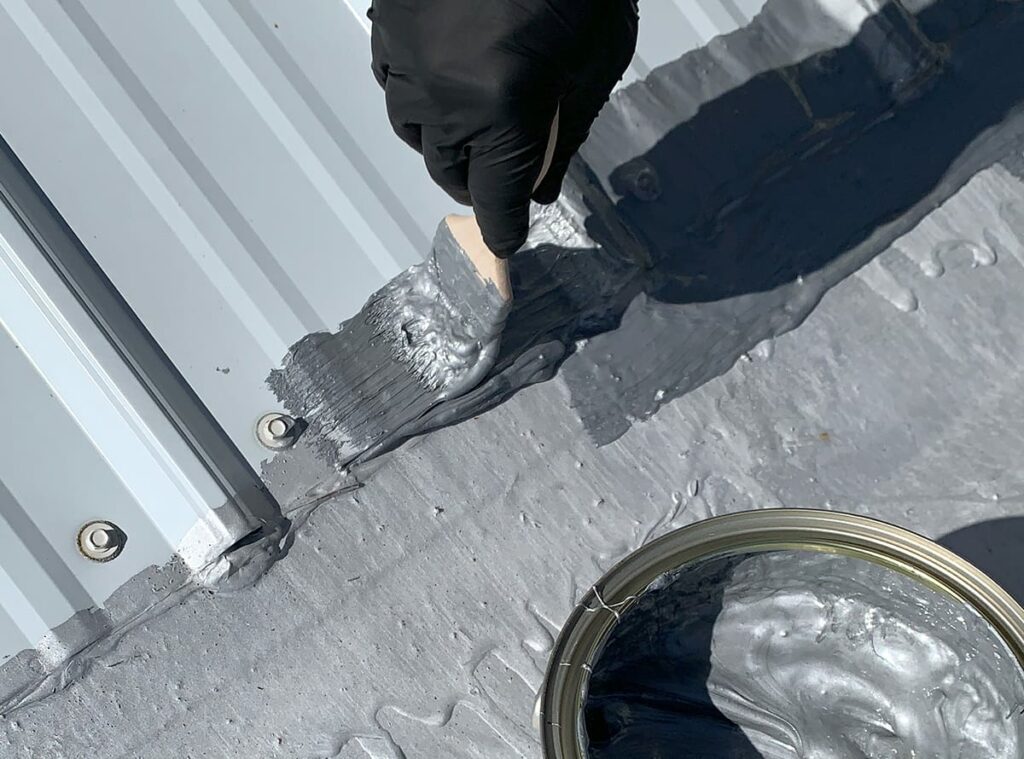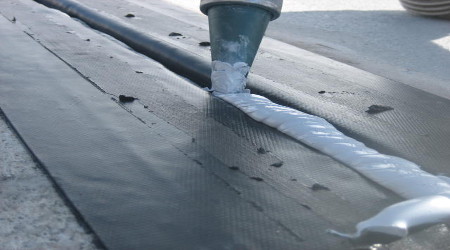Mastic adhesives are specialised bonding agents commonly used in construction, formulated from a blend of synthetic resins, rubber, and solvents. Due to its unique composition it adheres effectively to various materials such as wood, metal, concrete, and masonry. Its flexibility and durability enable it to accommodate structural movement and resist environmental wear. Additionally, its sealing properties prevent water ingress and enhance the strength of joints. By creating strong, long-lasting bonds, it ensures structural stability and enhances the longevity of both new and renovated buildings.
Mastic adhesive is used in a variety of construction applications, including:
Sealing and Waterproofing: Used to seal joints and gaps around windows, doors, and other openings to prevent water and air infiltration, enhancing energy efficiency and protection from the elements.
Roofing: Applied to seal seams, overlaps, and flashings on roofs, ensuring a watertight and weather-resistant surface.
Flooring Installation: Bonds tiles, vinyl, and carpet to subfloors, providing a strong, durable attachment that withstands foot traffic and environmental conditions.
Wall Cladding: Adheres wall panels, tiles, and other cladding materials to vertical surfaces, offering both structural support and aesthetic finishes.
Construction Joints: Used in expansion and contraction joints to accommodate structural movement while maintaining the integrity of the building.
Insulation Attachment: Secures insulation materials to surfaces, aiding in thermal efficiency and reducing energy costs.
Precast Concrete Assembly: Bonds precast concrete elements together during construction, ensuring stability and structural cohesion.
Advantages of mastic adhesive:
- Accommodates structural movement, reducing the risk of cracks.
- Ensures long-lasting performance and resists wear and tear.
- Performs reliably in diverse environmental conditions, including moisture and temperature variations.
- Seals joints and gaps effectively to prevent water infiltration.
- Simple to apply using standard tools and methods.
- Many formulations cure rapidly, allowing for quicker project completion.
- Suitable for a wide range of applications, including sealing, bonding, and waterproofing.
- Offers high performance at a relatively low cost.
- Withstands physical stress and impact without losing effectiveness.
- Resists many chemicals and solvents, maintaining stability in challenging environments.
- Improves energy efficiency by sealing gaps and enhancing thermal insulation.
- Resists UV degradation, maintaining appearance over time.
- Provides a strong bond that can support substantial loads and stresses.
Mastic adhesive types
Silicone Mastic: Silicone mastic is a high-performance adhesive composed of silicone polymers, renowned for its flexibility, durability, and resistance to extreme temperatures and environmental conditions. This mastic excels in applications requiring a long-lasting seal that can withstand a broad temperature range, from very low to very high temperatures. Its advantages include excellent UV resistance and weatherproofing capabilities, which ensure that it maintains its seal and performance over time. Silicone mastic is commonly used in glazing applications to seal window panes, as well as around doors and other openings exposed to the elements. Its non-corrosive nature and ability to maintain flexibility under stress make it suitable for a variety of construction and maintenance tasks.

Polyurethane Mastic: Polyurethane mastic is a versatile adhesive known for its strong bonding capabilities and resistance to environmental factors. This type of mastic combines high adhesion strength with flexibility, making it suitable for applications where significant structural movement and environmental stress are factors. Its advantages include superior resistance to moisture, chemicals, and UV radiation, ensuring long-term durability in challenging conditions. Polyurethane mastic is often used for sealing joints in concrete, asphalt, and other building materials, as well as in construction and industrial environments where a robust and flexible bond is required. Its durability and resistance make it ideal for both interior and exterior applications.

Acrylic Mastic: Acrylic mastic is a water-based adhesive that is valued for its ease of use and versatility. It offers good adhesion and flexibility, making it suitable for a variety of interior bonding and sealing tasks. The advantages of acrylic mastic include its quick drying time and paintability, allowing for a clean finish and aesthetic integration with surrounding materials. It is also easy to apply and clean up with water, making it user-friendly for various applications. Acrylic mastic is commonly used for sealing gaps and joints around windows, doors, and trim in residential and commercial buildings. While it may not offer the same level of weather resistance as silicone or polyurethane mastics, it is ideal for indoor environments where ease of application and quick curing are prioritized.

Hybrid Mastic: Hybrid mastic combines the properties of silicone and polyurethane to deliver a versatile adhesive solution that balances flexibility, adhesion, and durability. This type of mastic is designed to perform well in a range of conditions, including exposure to UV light and extreme temperatures. Its advantages include a strong, reliable bond to various substrates and the ability to handle both interior and exterior applications effectively. Hybrid mastic benefits from the strengths of both silicone and polyurethane, offering a robust, long-lasting seal that adapts to different environmental factors. It is used in construction and industrial applications where a combination of high performance, flexibility, and environmental resistance is needed.

Epoxy Mastic: Epoxy mastic is a high-strength adhesive that consists of epoxy resins and hardeners, known for its exceptional bonding capabilities and chemical resistance. This type of mastic forms a strong, durable bond that can support heavy loads and withstand harsh conditions. Its advantages include high resistance to chemicals, impact, and wear, making it suitable for demanding industrial environments. Epoxy mastic is often used in applications such as structural repairs, equipment reinforcement, and environments exposed to severe chemical and physical stresses. Its robust performance and durability make it a preferred choice for high-performance applications requiring a strong, reliable adhesive.
Different method used for applying mastic adhesive
Several methods can be employed to apply mastic adhesives, each suited to different types of projects and materials. Here are some common methods:
Caulking Gun: This is the most common method for applying mastic adhesives, particularly for sealants and adhesives used in construction and home improvement. The mastic is placed in a cartridge, which is then inserted into the caulking gun. The adhesive is dispensed by squeezing the trigger, allowing for precise application along joints, seams, or gaps. This method is ideal for both small and large-scale applications and offers control over the amount and flow of the adhesive.
Trowel Application: For thicker mastic adhesives or when working with large surfaces, a trowel may be used. The adhesive is spread evenly over the surface using the trowel, which helps to create a uniform layer. This method is commonly used in flooring applications where the mastic needs to be applied across a broad area before laying tiles or other materials.
Brush Application: A brush can be used to apply mastic adhesive in areas where a precise, controlled application is needed, or where the adhesive needs to be spread thinly. This method is often used for sealing smaller gaps or joints, and for applications requiring a more detailed approach.
Roller Application: Rollers are employed to apply mastic adhesives over larger, flat surfaces. This method ensures an even distribution of the adhesive and is useful for projects like applying mastic to large floor areas or walls. Rollers are particularly effective when working with mastic adhesives that have a thicker consistency.
Hand Application: For small, intricate applications or touch-ups, mastic adhesives can be applied by hand using a spatula or similar tool. This method is often used in situations where precise control is needed and where the use of a caulking gun or other tools may be impractical.
Conclusion
Mastic adhesive excels in providing strong, durable bonds for a wide array of materials. Its flexibility and resistance to environmental conditions make it ideal for both construction and repair tasks. By ensuring reliable performance and lasting adhesion, mastic adhesive is an important product for achieving high-quality, enduring results in various applications.
Image Source: decorexpro.com, unitedasphalt.com, terraco.com, facilitiesnet.com

